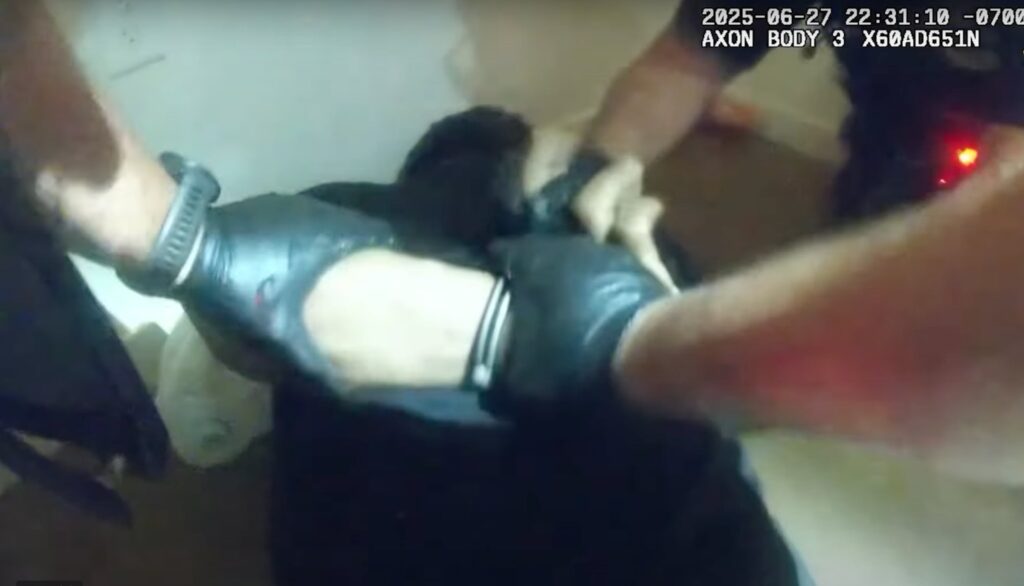Police are advised to put people on their sides once they’re restrained in handcuffs – something that didn’t immediately happen when a
52-year-old man
suffering a mental health crisis died last month after Portland officers kept him face down on his stomach before realizing he was unresponsive.
A national research group, which has trained Portland police in the past on how to defuse encounters with people in crisis who may be armed, released an extensive study last year on
how to reduce restraint-related deaths
, reiterating the best practice after
an investigation by The Associated Press
identified more than 1,000 people who had died nationwide while police tried to subdue them.
“I don’t think this problem has received the attention it deserves,” Chuck Wexler, executive director of the Police Executive Research Forum, wrote in announcing the study.
Portland Police Chief Bob Day said he can’t say yet if the three officers followed their training in holding and struggling to handcuff an agitated Damon Lamarr Johnson for several minutes on the floor of his apartment June 27 after police had been called due to his erratic behavior.
But Day said investigators will look at why they didn’t place Johnson in a “recovery position” as they have been taught for years to do.
Police are awaiting the results of ongoing criminal and internal police investigations, the medical examiner’s determination of what caused Johnson’s death and toxicology reports.
The investigations will look at “whether there was an opportunity to reposition” Johnson, Day said.
Portland police policy bans the use of a so-called hobble or hogtie restraint using a nylon strap to tie together a person’s ankles and wrists handcuffed behind the back.
Otherwise, a policy called “Ensuring the Safety of Restrained Persons” directs Portland police to “when feasible, ensure restrained persons are in a standing, seated, or recovery position (lying on their side).”
And officers are to summon emergency medical help as soon as possible if they observe a restrained person developing respiratory, cardiac or other severe medical stress, according to the policy.
In Johnson’s case, the officers ordered him to “stop resisting, roll over … roll over on your side,” according to body camera footage released by police.
But the videos also show the officers – Jason Epton, J.P. Duque Valencia and Travis Wortman – held Johnson on his stomach, with his hands cuffed behind his back, placing pressure on his legs and back for about four minutes
before they grew concerned.
“Is he breathing?” an officer is heard asking after those minutes passed. “Where’s the paramedics at? Turn him on his side.”
Paramedics arrived and found Johnson with a weak pulse, asked to have his handcuffs removed. He was taken by ambulance to a hospital, where he was pronounced dead.
The chief also said the investigation will also examine an apparent five-minute delay in the arrival of ambulance paramedics at the apartment once they were asked to respond. At one point, police had halted Portland fire medics from responding, the camera footage indicated.
The Police Executive Research Forum convened police, emergency medics, doctors and tactical experts a year ago and completed a study in September with 15 recommendations.
Wexler said restraining people who are in some type of distress is among the most challenging and risky situations for police.
The forum, a Washington, D.C.-based independent organization that researches policing, urges police to recognize that they may be dealing with a person in crisis who needs medical care rather than a person intentionally defying their directions and that the person may face a greater risk of death when police restrain them.
While putting a person face down is the most common and effective means of getting handcuffs around someone’s wrists, the person “should be removed from the prone position as soon as possible,” the forum’s report said.
“Restraining someone in the prone position can be dangerous, not because it impedes their ability to inhale oxygen, but because it interferes with their ability to effectively eliminate carbon dioxide, which can in turn lead to metabolic changes that may culminate in prone restraint cardiac arrest,” the report said.
Often officers relax their response once they get someone who is resisting arrest in handcuffs, but the forum said that’s the worst thing to do.
Officers must immediately move a person onto their side, the report said. Though it may be challenging to do so, “officers must make every effort to do so,” the report said.
“It is often while people are handcuffed and in the prone position (frequently with officers holding them down) that they become unresponsive and die,” the study said.
It also advises “hands-on” restraint may not be needed except in extreme instances.
“Police need to understand that restraint carries its own risks and should only be used if they’ve concluded that the individual is an immediate threat to themselves or could reasonably harm others,” according to Victor Weedn, Maryland’s former chief medical examiner, who is quoted in the report.
If restraint is necessary, the forum suggests police wait until emergency medical workers are on scene or nearby.
It also notes that the New York Police Department and other agencies are starting to
use Brazilian Jiu-Jitsu-based techniques
to safely restrain people quickly and “maintain them on their sides,” rather than hold them down with their chests to the ground. The so-called Jiu-Jitsu “safe wrap,” system directs officers to wrap their arms around the limbs of a person while the person is on their side instead of pressing someone’s chest to the ground.
Other tactics that appear promising include moving agitated patients onto backboards and removing restraints as safely as possible, the report said.
The forum also recommended working with emergency services workers and dispatchers beforehand to identify potential warning signs and figure out how to coordinate care when such calls come in.
Police were called to Johnson’s North Portland apartment on reports that he was flooding his room, hanging knives outside his window and spreading shaving cream on the hallway walls.
The officers were reluctant to enter his apartment unit and asked Johnson more than once to step out but he wouldn’t, according to the body camera video.
They ultimately stepped inside after deciding to have him placed on a police hold for transport to a hospital. That means police would have him held at a hospital for evaluation due to a mental health concern.
When the officers moved into the room, they found Johnson facing his window and shoving a piece of cake into his mouth. That’s when they tried to handcuff him. He struggled with them and uttered high-pitched screams, according to the body camera footage.
The officers yelled, “Stop resisting, stop” and “We’re trying to help you. Stop moving. Stop resisting.” Johnson could be heard at one point shouting, “I surrender! I surrender!”
One officer responded, “Once you’re in cuffs, we will ease up.”
According to the Police Executive Research Forum study, one officer at the scene should be designated a “safety officer,” to continuously monitor the person’s condition during and after restraint because unconsciousness can occur suddenly and advance beyond resuscitation within seconds.
Cardiologist Alon Steinberg, who chairs cardiology at Community Memorial Hospital in Ventura, California, said in the report, “What I see a lot is people who are kept in a prone restraint. They are no longer struggling, and no one’s checking if they’re breathing. When someone remembers to check, it’s too late.”
One of the three officers involved in the Portland case, Duque Valencia, recently graduated from bureau training to serve as an Enhanced Crisis Intervention Team officer, meaning he received more than the required 40-hour crisis intervention training that all officers must complete.
But Day said the city needs to find a non-police response for such a call.
“At the end of the day, this is not the right response model. This is not who we need to go into these calls,” he said at a news conference. “These are highly complex situations with people that are in deep crisis, and that crisis could be drug affected, that crisis could be mental health. We don’t know what the crisis is, but I know that I am committed to looking for alternatives for that.”
The Mental Health Alliance agreed with Day and separately urged an independent investigation into Johnson’s death that would be made public.
The alliance, which advocates for people suffering from mental illness, said a non-police program such as Portland Street Response should have dealt with Johnson because he wasn’t making any threats with weapons at the time and hadn’t committed any crime.
Portland Street Response workers, though, aren’t available around-the-clock and don’t go to scenes that involve weapons or other immediate threats. Johnson was reported to have knives, police said.
“The effective way to reduce misuse of force by police against people experiencing a mental illness crisis is to eliminate contact between police and those people in crisis,” the alliance said in a statement.
— Maxine Bernstein covers federal court and criminal justice. Reach her at 503-221-8212, mbernstein@oregonian.com, follow her on X
@maxoregonian
, on Bluesky
@maxbernstein.bsky.social
or on
LinkedIn
.





More Stories
Police restraint tactics questioned after Portland man’s death in custody
Police restraint tactics questioned after Portland man’s death in custody
Police restraint tactics questioned after Portland man’s death in custody